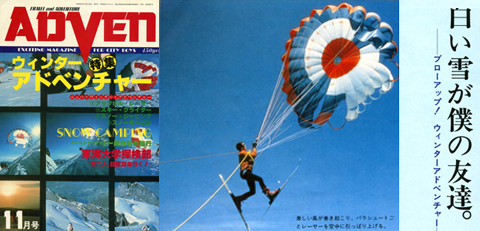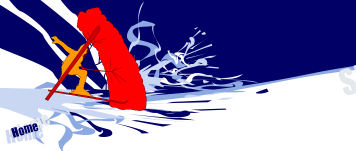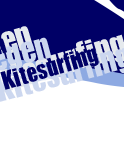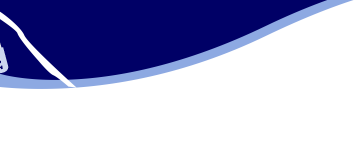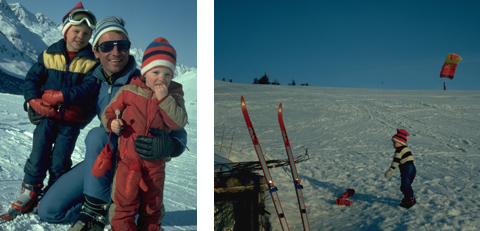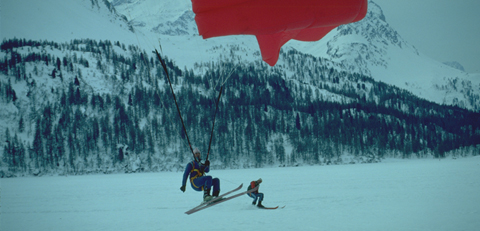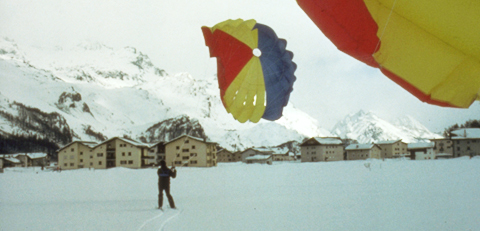DEVELOPMENT AND EXPERIMENTS TO OPTIMIZE FLIGHT AND GLIDING CHARACTERISTICS
DESCRIPTION OF PHOTOS DOCUMENTING THE EXPERIMENTS
GLIDE ANGLE:
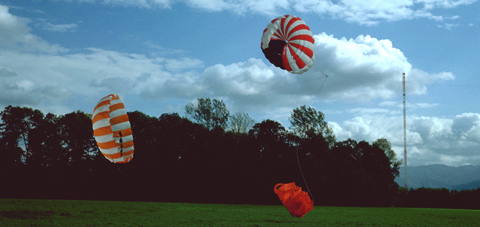
Glide angels and maneuverabilty of round and square parachutes were tested with several models in direct comparison. For this purpose the chutes were attached to a long rope. Subsequently their individual ceiling and angle of climb were determined.
AIRFOILS:
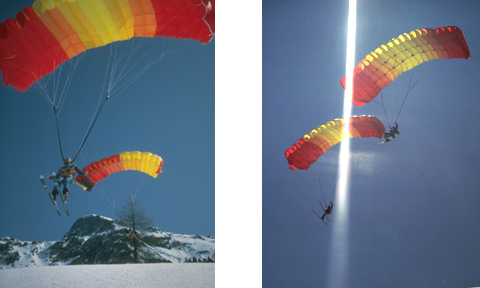
Top right: Different airfoils where tested in direct comparison with two paraglides. Tests were performed above the steep glacier of Piz Corvatsch, only a few meters above the snow (mostly powder) - for security reasons. We chose thick airfoils for good slow flight qualities. After all the "pulling sail" was supposed to soar in light wind, take off with the pilot at a running speed of no more than 15-20 km/h and gently touch down again.
ASPECT RATIO:
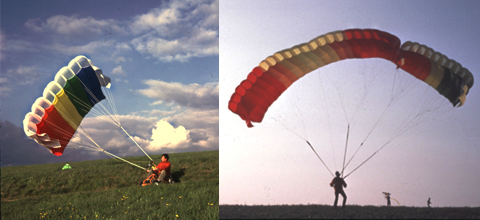
The bigger the aspect ratio, the smaller the drag induced by the tip vortex. For this purpose, paraglides with different aspect ratios were attached together with a zip (top right) and tested in flight above the glacier for a direct comparison. The picture in the top left shows the comparison of a 9-cell model (wing span 9m) with a 11-cell model (wingspan 11m). The 11-cell model had the best aspect ratio and was refined to the Skywing, winner of the 'Coupe de Finesse' (Saleva, 1986)
MAXIMUM WINGSPAN:
Gliding test of a 16-cell model - a combination of a 11-cell and 5-cell model (top right). This combination was suitable for skisailing, but not for flying. A further improvement of the glide angle was aimed at by an increase of the aspect ratio. A 13-cell model formed a front rosette during the flight, though, which changed into a back rosette in the breaking process, leading to a sharp descent when stalling.
ELLIPTICAL SHAPE:
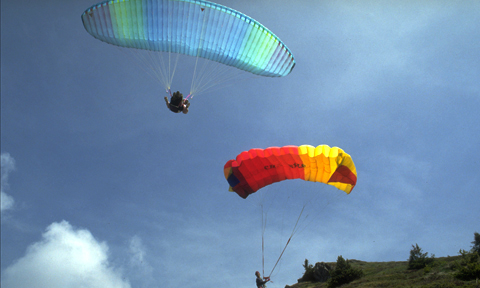
An elliptical shape can prevent this kind of instability. Back then, creating an elliptical paraglide still came with with high costs (s. image "White Stone - Gleitschirm 9/92). Comparison of an old rectangular Skywing with a modern paraglide in Verbier (s. image above).
BIPLANE:
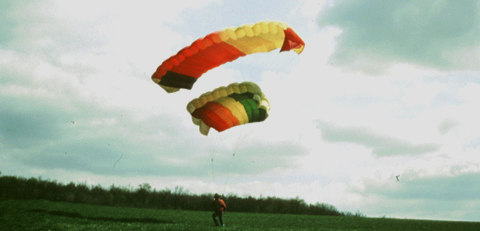
A big surface with high "Verwindungstabilität" stability can also be created by using a biplane. Image: A 9-cell model is attached with a 5-cell model, forming a 14-cell chute. This contruction turned out to be dangerous in slow flight, however, since the upper surface collapsed in the lee side vortex of the lower surface when using a higher angle of attack.
SPINNAKER FABRIC INSTEAD OF PARACHUTE SILK:
Skisails and paraglides made from conventional parachute fabrics would often become heavy in the process of sailing due to the absorption of water. After a day of sailing, a 4 kg chute would be 10 kg heavier, i.e. we had to carry home backpacks weighing 15 kg in the evening. From 1970 onwards, we therefore chose spinnaker fabric for our round and rectangular canopies as it would quickly dry in the air after ground contact in the course of sailing and flying. At the launch it would also open much quicker since it did not adhere to the ground. In addition we noticed this coated fabric was airproof and more inflexible, thus improving the aerodynamic shape.
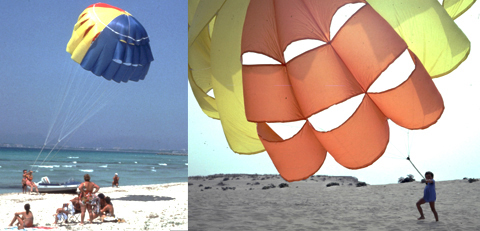
Image: A few minutes after a water landing, this round canopy made from spinnaker fabric has dried in the air.
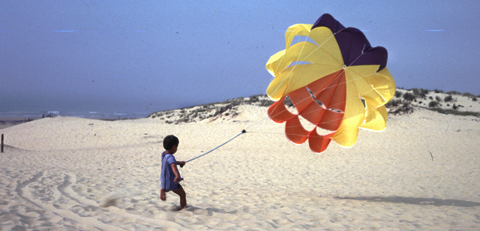
SIZE OF THE TESTED SAIL SURFACE:
Picture of Christoph with mini chute: 4 m2
Round canopies: 4, 8, 16, 32 m2
Rectangular canopies: 15, 21, 27, 30, 33, 40 m2
LONG AND HALLOW CARRYING STRAPS:
To prevent a jumble of tethers and skies when going skisailing, we constructed 3 m long hollow ropes guiding the steering tethers. In this way, the kitesail which was in a higher place could also be put in a vertical position when tacking against the wind. Flying with a flatter calotte could improve the glide angle and also the pendulum stability.
SKYWING- STEERING ROD:
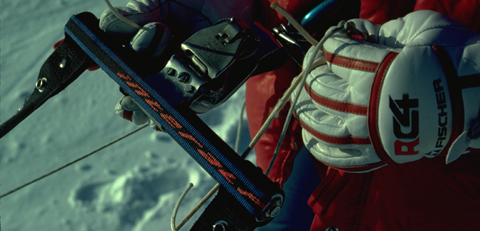
Presentation of the Skywing steering rod. The steering rod, rotatable in all directions thanks to a cardan joint, allows for gliding with the wind, flying against it and also for dynamic catapult launches cross to it. No matter in which direction the pilot turns, the tethers and steering tethers will always be clearly arranged and operable without any jumble.
RELEASE DEVICE FOR QUICK STOPS:
If the gliding trip is becoming to fast and dangerous due to increasing and gusty wind, it is possible to separate the canopy from the lap belt by releasing a security lock. With the help of the breaking tether it will then fold immediately. Afterwards it can be unfolded again without creating a jumble by using the retraction tether. If a back-up-chute has been brought, it is also possible to perform the separation in the middle of the flight.
AKROBATICS:
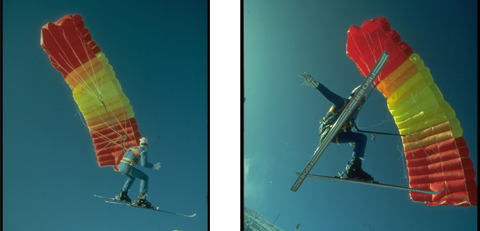
The steering rod also allows for dynamic catapults launches as demonstrated by D. Strasilla in this picture. Andrea Kuhn even knows how to fly back to front and do crazy acrobatics.
Skisailing in front of the Piz Palu
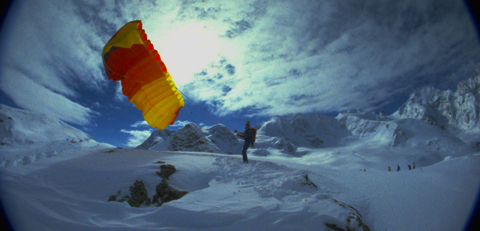
Gliding and flying in front of the Piz Bernina
TWO-SEATER STEERING ROD
The patented two-seater steering rod (CH patent nr. 675 568, steering device for a paraglide) allows for launching, flying and touching down side by side. Differences in weight between the pilot and the passenger can be levelled out by a slidable suspension device. This contruction is ideal for training purposes since the flight instructor is able to take a position in front of the student with the help of the cardan joint, thus being able to give instructions, take photos or make a film.
CATAMARAN WITH KITESAIL (two windsurf boards)
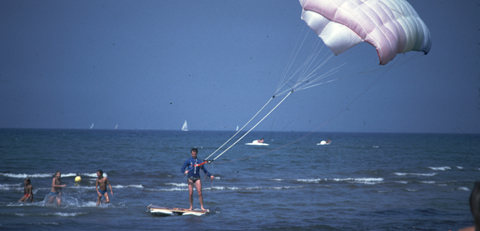
A 5-cell kitesail attached to a catamaran made made of two windsurfing boards is tested on the Mediterranean in this picture. Holding the sail in a free and straight posture became impossible when the sail surface was bigger and the wind blew stronger; it had to be attached to the boat hull subsequently. On a yacht, it was possible to choose a low suspension point on the deck. In this way the sail surface could be considerably increased whereas the heeling became only slightly stronger. The Skywing sail was set during the boat ride using the "Spinnakerfall".
Buggy (Go-kart) Sailing on meadows, sand sailings
Test of a go-kart with a 5-cell kitesail in the Tuellinger vineyard above Weil/Basel. High speeds in this variety can be achieved with Buggies (vehicles with a broad wheel base and thick tires), especially on North Sea beaches.
Andrea Kuhn has already successfully tested Skywing sailing on roller skates, inline skates, grass skis and roller skis.
BREAKING TETHER:
The breaking tether allows for a controlled, quick stop - also in the middle of the gliding trip.
THERMAL BREAK:
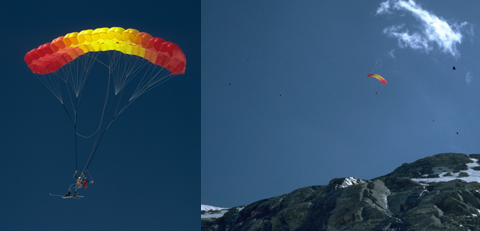
If the thermals are too strong, a reefing line helps reducing the size of the paraglide since regular methods of descent (big ears, b-stalls, deep spirals) cannot be applied due to the great distance between the tethers and the pilot. I have equipped my Skywing with a reefing line installed in the hollow straps in order to deal with strong thermals. Pulling this line, I can fold up the surface at will (like a concertina) and thus descent with a smaller, maneuverable canopy.
WIND CHANNEL SUBSTITUE:
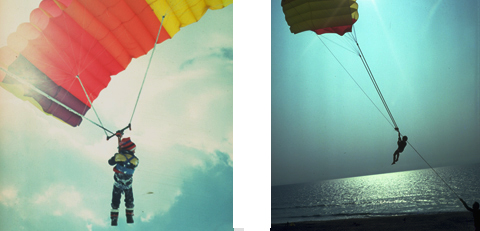
Test of a Skywing in light wind. My 5-year-old son Christoph was the ideal test pilot for light winds. An ideal testing gorund with laminary westerly winds were the hills of Tuellingen above Weil am Rhein, the Feldberg in the Black Forest, the Schauinsland and the Belchen (before the ban on flying). They served as a wind channel. Jamboree at the bottom of the "Dune de Pilat" close to Arcachon in France. The soft sand allowed for touch-and-go-flying in swimming trunks.
SKYWING AND FAMILY FUN:
During many of the tests my kids Christoph and Bernhard were present. Bernhard totally enjoyed being towed in a plastic tub, Christoph preferred flying. My wife Anette made a high speed gliding trip across the frozen lake from Silvaplana to Sils Maria.
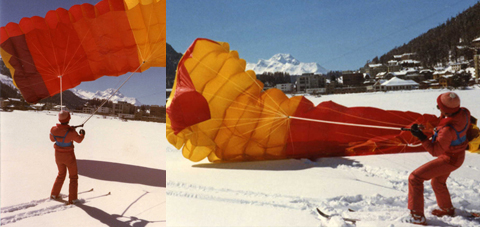
Anette Strasilla launching a Skywing on frozen Lake St. Moritz (destination: Maloya).
A STROLL ON THE WATER:
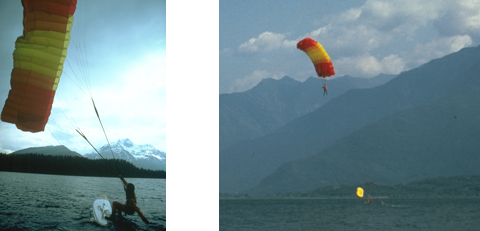
Andrea's first attempts at kitesurfing. With a jet fighter brake parachute serving as an anchor in the water we could easily go for a stroll on the waters of Lake Como. To deal with calms, we would always bring a rubber boat or an air mattress in tow. In stronger gusts of wind also the boat would go up in the air, though. This attractive variety might become a new type of sport, too. The use of a maneuverable fin would also allow for tacking against the wind high above the water surface. In strong wind my brother Udo was able to bounce up and down on the water like a yoyo: The wind surfing board construction would act as a brake, he would soar, the board would jump out of the water, the pilot would glide down into it until the board would act as a brake again etc.
At the sea and at the world cup near St. Moritz I have so far seen all varieties of this sport described in my patents - except this one. I'm sure this way of walking on the water (wether it's close to the surface or high above) will soon be a popular sport, too. I can imagine competitions where lots of gliders march across the sea from one coast to the other without getting their feet wet.
Dropping of skies before the touch-down:
Small parachute for ski recovery (s. artice > Magazines > Fischer Magazin)
SKYWING IN JAPAN:
Also in Japan our skisail and the Skywing were introcuded in professional journals "Adven" and "Skier" as early as 1978 and 1984. We are proud that in this way the development of the dynamic paraglide was also triggered on the far side of the world.
